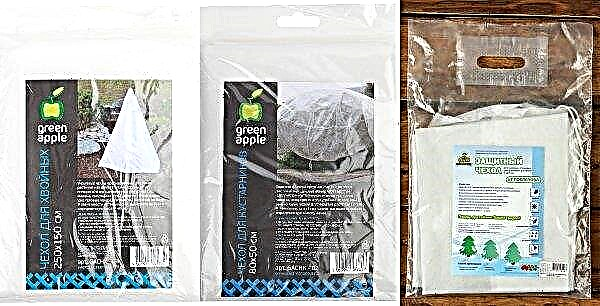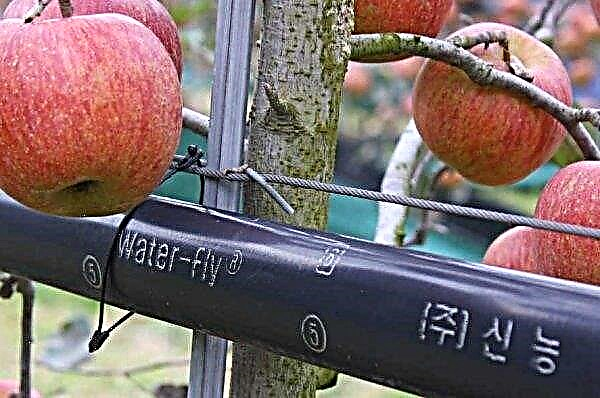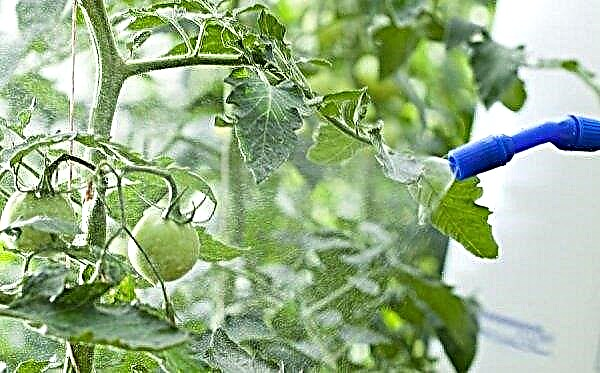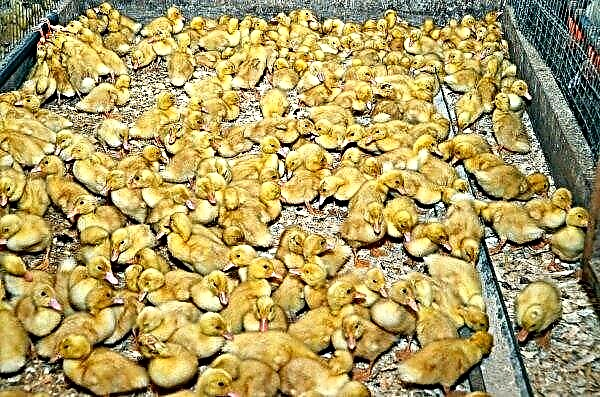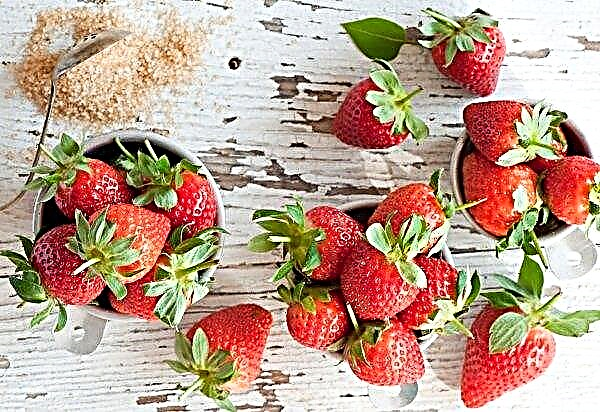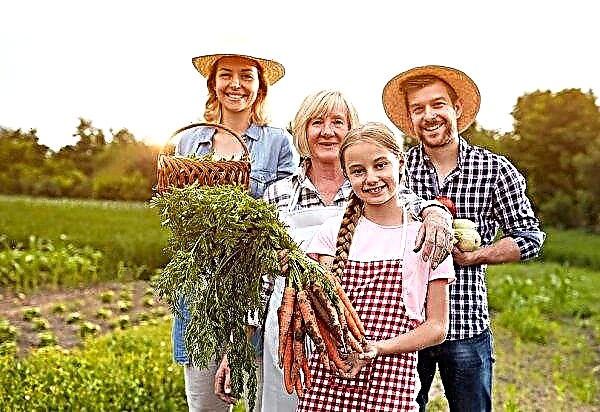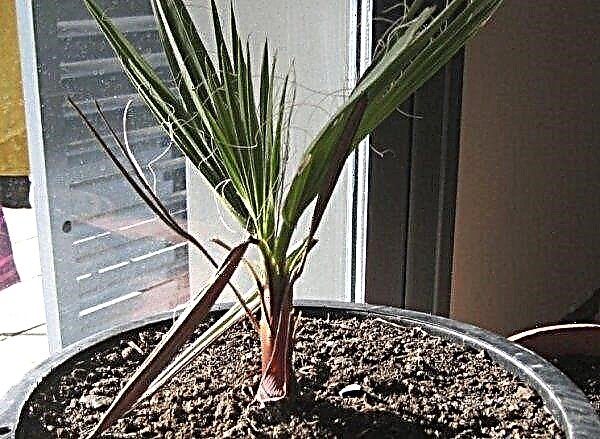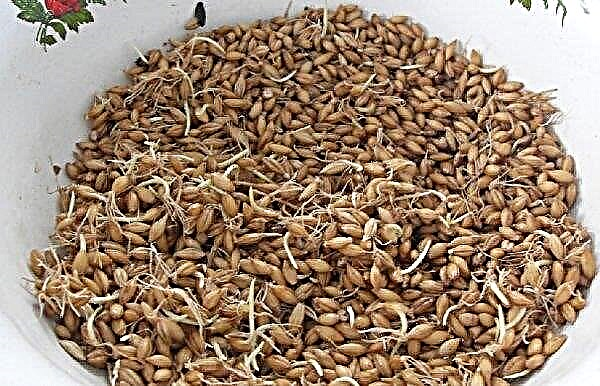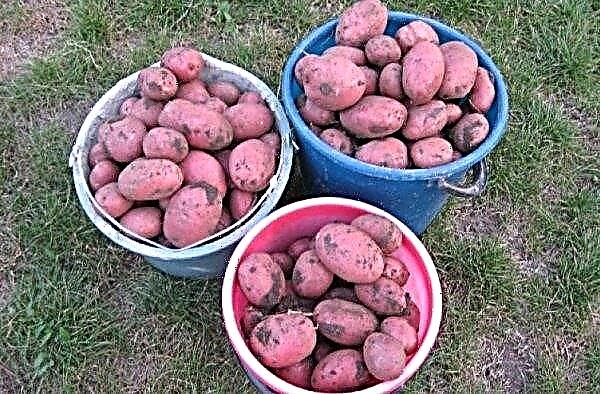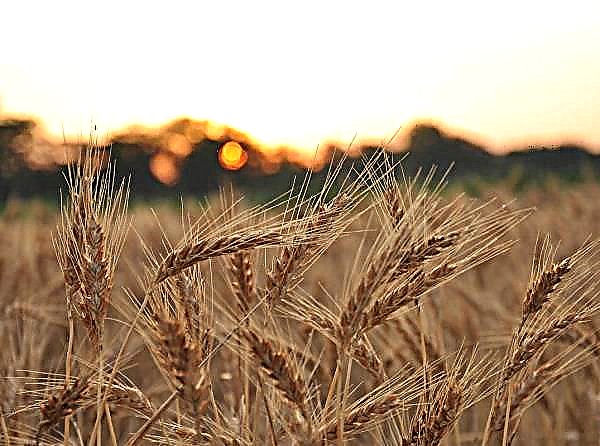Since the middle of winter, the thoughts of gardeners and summer residents are busy with questions about the upcoming planting of seeds for seedlings and further operations in greenhouses and on the open ground. This article will focus on the variety of tomatoes Katrina F1, its general description and characteristics, advantages and disadvantages of selection, productivity, exacting care and maintenance, possible diseases and pests and means of combating them.
Important! Around the freshly planted seedlings for the first time it is recommended to put in a circle a fence made of plastic, kapron, thick cardboard, which will serve as protection against fogs, winds and ground pests.
Description and characteristics of tomato varieties
Tomatoes of the Katrina variety have excellent characteristics, which made them one of the most popular and often planted both among experienced farmers and gardeners, and among summer residents:
- This tomato variety is characterized by early ripeness, the first fruits can ripen already on the 80th day from the moment of seed planting in open ground.
- Bushes of rather large sizes, with a lush deciduous crown, reach from 85 to 125 cm in height and over half a meter in diameter.
- The deciduous cover is saturated green, soft and silky to the touch.
- The stalk is strong, resilient and rather thick, which allows it to hold such a crown and many fruits.
- On average, about 5 kg of fruits can be collected per season from one bush of tomatoes of this variety. Fruits have a rounded shape, fleshy, bright scarlet color. The average weight of one tomato varies in the range of 150–250 g. Inside, they have a uniform and uniform texture, taste good and have a pronounced tomato aroma.
- They are suitable for home growing in small volumes on your own personal plot, as well as for large-scale production in greenhouses and in open fields.
- Unpretentious in care and maintenance, easily adapt to temperature and weather conditions, tolerate temperature fluctuations characteristic of a temperate continental climate.

Advantages and disadvantages of the variety
- The inherent benefits of this tomato variety include:
- high productivity;
- unpretentiousness to the conditions of detention and care;
- the bush is medium-tall, and therefore it will be easy to care for and collect fruits;
- the variety is highly resistant to temperature extremes and various diseases;
- the fruits are large, fleshy, tasty, do not crack, are well stored and tolerate transportation;
- the variety is suitable for growing both in open ground and under the cover of a greenhouse.
Features of planting and growing at home
If on large farmlands there is already a clear technology for planting various crops, then for summer residents and owners of their own private land plots this question remains open. Let us consider in more detail the features of planting and growing at home tomato variety Katrina.
Did you know? In addition to a huge number of useful elements, tomatoes contain serotonin, called the hormone of happiness, because tomatoes are considered an excellent remedy for depression, because they can raise the mood.
Optimal conditions
One of the fundamental factors for the successful cultivation of tomato seedlings at home will be the creation of optimal conditions, which include temperature, lighting and humidity. The ideal temperature regime will vary in the range of +20 to +25 degrees. The minimum allowable air temperature is +18 degrees.
If the temperature is lower, then the growth will decrease significantly or may even stop. Moderate humidity of 70–80% will also contribute to the growth and development of seedlings. You can track this indicator using a special device or simply periodically arrange spraying from a spray bottle to humidify the air in the room. Especially it is necessary to monitor humidity if your room has a large battery, which significantly warms and drains the room. Wet cleanings will not be superfluous. As for lighting, it is better to choose the southern windowsill, which will capture the maximum of natural light. If the day is still not long enough, then in the evening you can illuminate the seedlings for 2-3 hours using a conventional incandescent lamp.
Especially it is necessary to monitor humidity if your room has a large battery, which significantly warms and drains the room. Wet cleanings will not be superfluous. As for lighting, it is better to choose the southern windowsill, which will capture the maximum of natural light. If the day is still not long enough, then in the evening you can illuminate the seedlings for 2-3 hours using a conventional incandescent lamp.
Sowing preparation
To grow strong, healthy and strong seedlings at home, you will need to choose the optimal soil mixture in a specialized store or prepare the substrate yourself. If the second option is chosen, it will be necessary to mix humus, wood ash and sawdust in certain proportions, add superphosphate and the earth itself (it is advisable to take it from the site where you plan to plant seedlings in the spring).
Important! Pre-treatment of seeds with growth preparations (activators, stimulants, growth regulators) will help accelerate the germination of seedlings and their resistance in the future in an open area. You can buy such in any specialized store.
Seeds purchased at the store should be soaked in a 1% solution of potassium permanganate to protect them and disinfect, as well as discard those that remain afloat. This is a good way to check before planting which seeds will sprout and which ones are best sent to the garbage right away. Those that drown are considered suitable; anything that floats on the surface cannot germinate.
Sowing technology
Sowing seeds should be two months before they are transplanted to a permanent place in the open ground. Thus, seed planting work can begin in mid-March so that seedlings are ready by May. You should not rush and start planting in February, because then by the time the soil warms up enough and serious temperature differences cease to act at night, the seedlings will simply outgrow, and it will be difficult for it to take root in a new place. Planting seeds is carried out in disposable peat or plastic pots with holes in the bottom to provide adequate ventilation, removal of excess gases and free passage of excess water. 2 grains should be planted on one pot, in case any of them still does not germinate. After that, it will be possible to remove the sprout that will be weaker, or to leave both plants and divide them into two holes already during transplantation.
Planting seeds is carried out in disposable peat or plastic pots with holes in the bottom to provide adequate ventilation, removal of excess gases and free passage of excess water. 2 grains should be planted on one pot, in case any of them still does not germinate. After that, it will be possible to remove the sprout that will be weaker, or to leave both plants and divide them into two holes already during transplantation.
Planting seedlings in a permanent place
One of the main factors for the successful cultivation of an abundant tomato crop is the choice of a good site and the right soil. Almost all varieties of tomatoes, including Katrina, are quite demanding on the ground, and therefore it is advisable to choose breathable, light and best loamy soil.
Special attention deserves control over the acidity of the soil and its mineralization. The site should be prepared in the fall. During this period, the plantation should be dug to the depth of the spade bayonet, and phosphorus and potassium fertilizers should be applied according to the instructions. In the spring, a similar procedure is carried out, only nitrogen fertilizers are already being introduced.
Seedlings are planted on the 60th day from the moment of sowing seeds. At the same time, make sure that the soil has warmed up enough, and that at night there are no serious temperature differences. So you can maximally protect still immature shoots from the harmful effects of climatic and weather factors. To land, dig a small hole half a bayonet deep with a shovel. After shedding the hole with means against the larvae of the May beetle and the bear (the most fierce enemies of the summer resident). Sprinkle generously with wood ash and ash, which will also be a good way to protect young seedlings. Next, carefully remove the seedlings with a lump of earth and place in the hole. Sprinkle with loose earth, additionally spill a liter of water on the bush and again sprinkle with dry, loose earth. The recommended distance between seedlings is 60–70 centimeters.
Sprinkle generously with wood ash and ash, which will also be a good way to protect young seedlings. Next, carefully remove the seedlings with a lump of earth and place in the hole. Sprinkle with loose earth, additionally spill a liter of water on the bush and again sprinkle with dry, loose earth. The recommended distance between seedlings is 60–70 centimeters.
Tomato Care
In addition to observing the technology of sowing and growing, you should familiarize yourself with the further implementation of the rules for caring for tomatoes.
Important! WITH various dressings should be especially neat and careful, because their excessive amount can cause irreparable harm to the plant. Therefore, carefully read the instructions for various drugs and strictly follow the recommendations.
Fertilizer and watering
For tomatoes, three elements are important, which should contain almost all fertilizers - nitrogen, phosphorus and potassium. Sometimes, some others, including boron, copper and manganese, need to be added to these small quantities. Fertilizers based on phosphorus and potassium are recommended to be introduced in the winter during digging of the site. Nitrogen should be introduced before transplanting seedlings into the ground and then once a month as necessary.
A complete list of top dressing tomato is listed below:
- The first feeding is done in early June. For its implementation, you will need to dissolve in 10 l of water 0.5 l of cow manure, 2-3 tablets of pressed micronutrient fertilizers, 1 tbsp. l nitrophoski and 0.5 parts of boric acid. Dosage: 1 liter of mixture for each tomato bush.
- The second top dressing is carried out in a month, in the first days of July. The composition is the same, only 1 tbsp is added instead of boric acid potassium sulfate. The dosage is similar.
- To carry out preventive procedures to prevent the development of various diseases, it is advised to daily apply a solution of potassium permanganate under the root in a proportion of 5 g per 10 liters. Dosage: 200 ml for each bush.
- Before the fruiting period begins, add to the soil per 1 m²: 5 g of ammonium nitrate, 15–20 g of superphosphate and 4 g of potassium chloride. During fruiting: nitrate - 10 g, superphosphate - 10-15 g. The best method of application will be a liquid solution during irrigation.
- As for the introduction of organic matter, for example, manure or compost, in this case it is recommended to bring them in the autumn for digging at the rate of 2-3 kg per 1 m². After that, next season it will be possible to plant a tomato plantation at this place.
Watering is carried out as necessary 2-3 times a week in the evening. Monitor the condition of the soil by regularly checking for moisture in the area of the root system of the plant. If there is moisture under the upper dry layer, then it is too early to water. Garden weeds are excellent indicators of water sufficiency in the land, among which are field daisies, dandelions, knotweed, wheat grass, euphorbia and some others. After watering, be sure to fluff up the earth and sprinkle it with dry earth so that the moisture evaporates more slowly.
Shrub formation and pinching
The Katrina tomato variety does not need to be stalked if the bushes grow on the open ground in compliance with the previously prescribed distances between the plants. Due to their compactness and average height, tomato bushes are less damaged, and they do not need additional relief of the green crown. This is another advantage of this variety, for which he received such high marks from professional farmers and is used in agriculture and in private household plots.
Did you know? La Tomatina (Spanish: La Tomatina) is an annual large-scale festive event held on the twentieth of August in the Spanish city of Bunyol, located on the territory of the autonomous community of Valencia. Many thousands of tourists and participants of this event come from different parts of the world to see and participate in the battle, in which the “arms” are tomatoes.
If tomatoes are grown in a greenhouse, then to prevent decay and the development of mold damage caused by increased humidity of greenhouses, pinching is still recommended. The bush is formed in one or two stems, the upper shoots are cut off, starting from a height of 40 cm, to activate the growth of side shoots. When the ovary is formed, it is also recommended to prune the new shoots to allow the bush to put all its strength into the development and maturation of a high-quality and rich crop.
Soil cultivation and weeding
An integral part of garden work has always been weeding and loosening of soil. It is especially important to do this after rains or after irrigation, so that a dense and hard crust is formed on the surface that can damage the delicate root system, which can lead to negative consequences and even death of the bush.
Did you know? More than 10,000 different varieties of tomatoes are in the world today. At the same time, the smallest tomato does not exceed 2 cm in diameter, and the largest weighs almost 1.5 kg.
While the tomatoes are small, loosening must be carried out continuously after these procedures. When the bushes grow, weeding can be canceled. Thanks to the lush deciduous crown, the tomatoes themselves will be able to protect the earth from direct sunlight and save enough moisture for their successful growth and fruiting.
Diseases and pests of tomatoes
As with other crops, spring is one of the most critical periods for growing tomatoes, as a large number of pathologies multiply with increasing temperature and humidity. Therefore, it is very important to know what the main pests and diseases of tomato exist, and to have an idea of how to avoid or control them:
- Powdery mildew - This parasitic fungus, belonging to the family Erysiphaceae, is one of the main diseases of tomatoes. Its most famous symptoms are the appearance of yellow spots on plants, which ultimately cause necrosis in the center. Manifestations also come in the form of a white powder on the underside of leaves and can lead to leaf fall. To prevent powdery mildew in a tomato, it is important to eradicate weeds and debris from previous crops and use special treatment to control it. In this sense, Certis ArmicarbR or TakumiR products are an excellent choice. ArmicarbR is registered for organic farming and is free of MRL. The domestic alternative is Antracol, Consento, and Tatu.

- Mold - this fungus affects different species of the nightshade family. In a tomato, it damages the aerial part of the plant at any stage of its development. The main symptomatology in tomatoes is the appearance of oily-looking spots that permeate almost the entire foliage. Brown spots also appear on the stem and on unripe fruits. To avoid mold, it is important to ventilate the tomato plantations in the greenhouse and make sure that there is no standing water on the leaves. It is also recommended to use a fungicide such as KdosR de Certis, or Hom, Oxychom, which help control this disease, in addition to certification for organic farming.

- Alternariosis - Among various diseases of tomatoes, it is also known under the scientific name Alternaria solani and, as a rule, affects all solanaceous plants. The main effect that the tomato causes is the rottenness of the fruit, although it can also affect the leaves, stalk and petioles of the plant. Round or angular spots appear on the leaves, sometimes a yellow halo appears. To prevent alternariosis, it is necessary to remove affected vegetables and plants, control humidity and use phytosanitary products that help eliminate this disease. To combat alternariosis, there are several drugs, for example KdosR and KocideR Opti, as well as Oxychom, Barrier, Barrier.

- Gray rot - This is a fungus that can cause the death of a plant. In adult plants, it causes brown damage to the stem and petioles, which penetrate into the stem.Soft rot appears on the fruits, and brown lesions similar to those of the stem appear on leaves and flowers. To prevent gray rot, it is important to control the level of nitrogen in the soil, remove plants already affected by this disease, and take special care when pruning. It is recommended to undergo chemical control by using a product that helps to eradicate the disease. Certis JapicaR, Scomrid Limb AerosolR, and CercobinR 50 SC products are ideally suited for eradicating gray rot from tomato plantations.

- Aphid - is the most common pest affecting tomato crops. As a rule, the pest causes deformations and bulges in the leaves. Aphids can transmit CMV and PVY viruses in tomato crops, which will lead to much more serious damage. To avoid this, it is recommended to eliminate weeds and the remains of other crops, as well as eliminate excess moisture. Other drugs like MospilanR, Breaker (registered for organic farming), Eradicoat and Sherpa 100 EC will also help you. From domestic preparations, stop your choice at "Karbofos" or a folk remedy - spraying with a soap solution.

- Whitefly - is a pest that multiplies very quickly. On the back, insects lay their eggs, and after some time, the first mobile larvae appear from them, which cause direct damage to the plant, as they absorb the juice from the leaves, causing yellowing and weakening of the plants. To avoid adversity, it is important to harvest weeds and not leave the crop at the end of the vegetative cycle, as young shoots attract adult whiteflies. Specialty stores offer a wide range of products that help fight whiteflies such as EradicoatR, MospilanR and BotanigardR. Of the domestic drugs, Confidor will do.

Harvest Dates
Already on the 80–85th day after sowing seeds into the ground, the first crop begins to ripen. Given that Katrina is an early variety, harvesting harvest will end by early August. Such a crop can be stored for a relatively short time, given that these tomatoes are not subject to long-term storage in fresh form. 10-15 days they can be stored in a cool place, for example, in the basement, and about 20 days in the refrigerator.
During this period, tomatoes are recommended to be eaten fresh or marinated and preserved, and also distilled for juice, taking into account indicators of taste and juiciness. You can store in small boxes, stacking tomatoes in a maximum of two layers to avoid stress on the bottom row and extend the shelf life of vegetables.
Guided by the information given in this article about the early and productive variety of tomatoes Katrina F1, it will not be difficult for you to carry out all the necessary work on preparing seedlings, planting them on your own site, caring for and maintaining plants, as well as harvesting, storing and processing it. As a result, your efforts will be more than justified by the tasty, fragrant and juicy harvest of ripe tomatoes.







